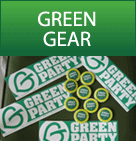Founding of the Green Party of California
The Green Party of California (GPCA) was founded on February 4th, 1990. It achieved ballot status as of January 1st, 1992. It has maintained ballot status ever since.
The Founding Meeting (February 1990)
The founding meeting of the GPCA occurred on February 4th 1990, at Cal State Sacramento. Approximately 65 Green delegates and observers from 30 Green locals gathered from across California and debated whether to start a new political party. The meeting was co-facilitated by Mike Feinstein (Santa Monica, Westside Greens) and Mindy Lorenz (Oxnard, Santa Clara River Greens).
A report was given by Kent Smith (Nevada County Greens) and Roger Picklum (Oakland, East Bay Green Alliance) on what would be involved in qualifying the party for the ballot. The vote to found the GPCA and go for ballot status was 27 locals in favor, 0 against and 3 stand-asides (East Bay, Fresno, and Ojai). Concerns expressed about the decision to go forward mostly centered upon whether Greens were ready to start a political party and whether electoral work would take energy away from non-electoral Green movement activity.
There were several other decisions made that day by consensus, including establishing committees to begin the platform and by-laws drafting process; appointing Lorenz, Danny Moses (Half Moon Bay Greens) and Dan Tarr (San Diego Greens) as empowered press contacts; and accepting a pro bono lobbyist for the state capital, Michael Twombley (Sacramento Greens).
At 3pm, reporters from local network affiliates came by and interviewed Lorenz and Smith. Later delegates paused during their nine-hour meeting to watch themselves on the six o'clock news. The party had arrived.
The Ballot Drive (January 1990 - December 1991)
To qualify for an ongoing place on the ballot, California Greens needed to gather a number of registrants equal to 1% of the number of people who had last voted in a general election for Governor (in 1988) - that number amounted to 78,992.
People began to register Green right at the beginning of 1990, even before California Greens officially voted to start the party. The first big registration push came on Earth Day 1990 - Greens tabled across the state at Earth Day events, registering new voters by the hundreds. San Diego did the best among all counties, registering approximately 1,000 new Greens that day.
By November 1990 however, only about 13,000 Greens had been registered, far short of the halfway mark needed to reach the required 78,992 by the end of 1991. Doing voter registration was still a relatively new task for many California Greens. With their inexperience and without the intensity of an impending deadline, county Green Parties were not undertaking the registration task in a well-organized, systematic manner. Also, the young GPCA was an even more decentralized body than it is today, and it lacked the statewide organization and structure to coordinate the ballot drive. That would all change at the beginning of 1991, with a push from inside and outside of the party.
• Inside (the Q Group) - with the ballot drive destined to fail by all indications, at the beginning of 1991 several Bay Area Greens took the initiative to form the "Q Group" - an ad hoc group to draft and implement a focused registration plan. Led by Ross Mirkarimi (San Francisco Greens), it also originally included Regina Endrizzi (San Francisco Greens) and Greg Jan, Picklum and Steve Bloom (all Oakland and East Bay Green Alliance). Others around the state played an advisory role, including Moses, John and Eleanor Lewallen (Mendocino County Greens), Gerry Gray (Humboldt County Greens), Genevieve Marcus and Bob Smith (Los Angeles) and the aforementioned Lorenz, Smith and Feinstein.
The Q Group sought to bring together people who had organizing prior experience, including hiring Joe Louis Hoffman, an organizer with a history of union organizing Chicago, to coordinate the effort. Over the course of early 1991, a plan took shape that included combining the registration drive with a party newsletter (Green Consensus) and a fundraising plan (which included raising money from each newly registered Green).
• Outside (the Gulf War) - at the same time the Q Group was getting off of the ground, bombs were being dropped on the ground in the Gulf War. The GPCA had a state meeting already scheduled for San Francisco in January 1991, which ended up being held just days after the U.S. bombing started. Suddenly the progressive movement was mobilized and focused. With both Congressional Democrats and Republicans voting to go to war, the desire for a progressive electoral alternative became more clear, and people began looking for the Greens, instead of the Greens looking for them.
On Saturday, January 19th, Greens temporarily adjourned their state meeting to take to the streets and join the estimated 150,000 people marching in the streets that day protesting the bombing. With clipboards and voter registration forms in hand, Greens registered approximately 700 people in about an hour and a half before returning to the meeting. This highly energized event helped get many party members 'over the hump' in terms of asking for registrations and created a broader cadre of Greens ready and able to do voter registration.
The pace of registrations began to increase and by August 1991, they had almost reached 35,000, approximately 42% of the way there with four plus months to go.
With the goal of 78,992 starting to become within reach, and with the Q Group's plan beginning to kick in for the stretch drive, help came from an unexpected place - the Democrats. The California Democratic Party's state political director made news across Northern California when it became public that he was returning newly registered Greens their registration cards with a letter asking them to 'unregister Green' and return to the Democratic Party. The negative publicity the Democrats received by trying to keep the Greens off the ballot sent people looking for Green Party registration totals in droves. The GPCA matched that intensity with a now well-organized statewide registration campaign with hundreds of Greens out registering new voters every weekend (and many weekdays) in high visibility locations.
By December 1st 1991, registration had reached 60,000 and the goal was near. Then a large, last minute large donation came in that would help pay to hire some professional registration gatherers. This spurred Greens on even more furiously, with the added confidence that the needed total could be achieved. After registering 60,000 people in the preceding 23 months, Greens registered 40,000+ people in December alone to 'go over the top' and reach 103,903, securing a place on the ballot for the GPCA. About 65,000 came from Northern California, evidencing the strength of Hoffman and the Q Group's efforts there, as well as reflecting the strength of the Green movement in that part of the state.
Pre-Ballot Drive: The Early Years 1985-1989 - The Green Committees of Correspondence are Formed, California Greens Begin to Meet in Locals Around the State
The founding national Green organizational meeting in the United States began in August 1984, when 60+ people gathered in at Macalaster College in Minneapolis to found the Committees of Correspondence (named after the small grassroots groups of the U.S. Revolutionary War) and adopt the Green Ten Key Values (which exist and unite U.S. Greens to this day). Among those in attendance was California Green Charlene Spretnak (Half Moon Bay Greens), co-author of several books on Green philosophy and spirituality, including Green Politics: The Global Promise - the definitive English language study of the German Green Party's early years, with Fritjof Capra (author of The Tao of Physics),.
Soon afterwards Greens began to meet in the San Francisco Bay Area in late 1984 and early 1985, with the San Francisco Greens and the East Bay Green Alliance being founded as bookend Green locals across the Bay. The East Bay Green Alliance's founding meeting came in Berkeley in May 1985, with Spretnak, Moses, and British Green spokesperson Jonathan Porritt, making presentations. In Southern California, a group began meeting around Los Angeles at the same time, including Marcus and Smith, Marc Sharon, John Stein and others.
Greening of the West
By the 1988, there were Green locals spread across California and many were meeting on a regional basis as well. At one regional meeting in Northern California, came the idea (and sponsorship) of the Greening the West gathering. Greening the West would be the second large-scale Greens Gathering ever in the U.S. The first was held in 1987, in Amherst, Massachusetts and drew approximately 1,000 people. Greg Jan spearheaded the organizing, along with dozens of Greens from around Northern California.
Greening the West was held in San Mateo County at the Jones Gulch YMCA camp, near La Honda, from Sept. 30 - Oct. 2, 1988. Over 1,000 people attended the event. Speakers included Fritjof Capra, Charlene Spretnak, Ernest Callenbach, Starhawk, David Brower, Bill Devall, Patricia Ellsberg, Harold Gilliam, Susan Griffin, Joanna Macy, Jerry Mander and Brian Swimme. Greening the West was one the first places where widespread discussion of starting a Green Party in California took place. Although no formal decisions were made, seeds of change were planted.
California Greens meet in Eugene, Oregon at Green Gathering 1989 (June 1989)
The first formal caucus of California Greens took place in 1989, but not in California. Rather it took place in Eugene, Oregon, at the 1989 national Green Gathering. Approximately 50 Greens met for the first time on a statewide basis, representing a partial mix of the California Green movement - including existing Greens from already established national Green Committees of Correspondence or GCoC (the then national Green organization), as well as more loosely affiliated Bioregionalists, Earth Firsters, members of the Abalone Alliance members and others,
Attendees found they had more in common with each other than some of them had expected. There had been the perception of both a Northern California/Southern California cultural/political divide, including one of the issues of the day in Green organizing at that time: 'social ecology' vs. 'deep ecology.'
The caucus voted in Eugene to propose to the existing California GCoC regions, that the first ever state meeting of California Greens be held in the fall. A small working group was set up that would convene the first ever formal state meeting of California Greens, to take place in the fall in Fresno (a location in the middle of the state.) Working group members were Smith, Tarr, Feinstein and Bob Long of San Pedro. The host organizer was Scott Werner (Fresno Greens)
Fresno - First Ever Formal Meeting of California Greens (November 1989)
California Greens held their first ever statewide conference in November 1989 at Cal State Fresno, with approximately 25 Greens from across California in attendance. Most of Saturday was devoted to a discussion of issues Greens from across the state might coordinate around.
On Saturday night, discussion about whether to start the party began. California Greens were facing an identity crisis. Between 1988 and 1990, an imposter Green group called 'Green Futures' or 'the Humanists' had applied for and received the right to the Green Party name as part of a two-year window to try and qualify the Green Party for the ballot in California. Since the Green Futures had not qualified the party (they achieved only about 800 voter registrations in two years), the right to the name would be coming up again for contest in early 1990.
At the same time, Democrats in California were drafted an unprecedented statewide environmental ballot initiative, "Big Green", which would ultimately go on the ballot as Proposition 128. Also at the same time, the Green movement in general was beginning to receive unprecedented attention, including from the media, with the coming of the first nationally celebrated Earth Day in twenty years - Earth Day 1990. The dilemma facing California Greens was that with all the attention upon 'Green', the idea that there was a distinct politically-minded organization called the Greens, would be lost in the Green Futures/Big Green/no separate Green Party confusion.
The decision that came out of the Fresno meeting was to send Smith and Picklum to Sacramento to talk to Ed Arnold, head of the Elections Division of the Secretary of State's office. Arnold would inform the Greens about what would be involved in both securing the Green Party name and achieving ballot status. Smith and Picklum would then send a report of their findings and recommendations to Green locals across the state, which would meet and discuss the findings and recommendations, and send delegates to the February 1990 meeting in Sacramento, to decide whether to found the Green Party of California.
Early Electoral Successes
The first Green to be elected in California was Bob Ornelas in November 1990, winning the first of what would be three City Council victories for him in Arcata between 1990 and 2000. Ornelas however, was not the first Green City Councilmember - Raven Earlygrow was appointed in August to fill a vacancy in tiny (pop. 440) Point Arena in Mendocino County. Like Ornelas, Earlygrow would serve for many years, remaining on the council through November 1998 and serving as mayor for four years. On the partisan race level in 1990, Lorenz qualified for the ballot as a write-in candidate for U.S. Congress in her Oxnard/Ventura/San Barbara district. She received 1% of the vote as a write-in, one of the highest for a write-in candidate on that level.
National Green Publications Coming Out of California
Several important national Green publications began out of California in the mid 1980s. In San Francisco, Jerry Gwathney published The Green Letter, a national Green newsletter, which later became Green Letter/Greener Times, with San Francisco Green Margo Adair and others joining the editorial collective. In 1988 Long renamed his long-running journal of economic democracy as Green Synthesis, which became the GCoC national journal. Both ran from the mid 1980s through the early 1990s. From 1997 to 2002, the national Green Party newsletter Green Pages was published out of Santa Monica by Feinstein.
See also: Western and national Green meetings, conferences, conventions and debates held in California
This GPCA historical account was written by Mike Feinstein, Santa Monica




